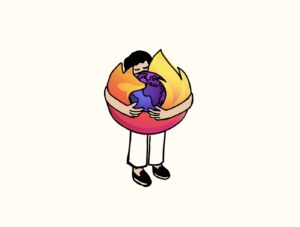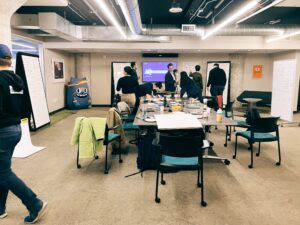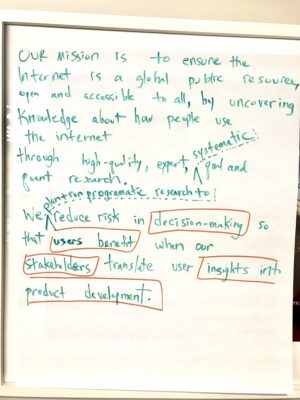How the Firefox User Research team crafted our mission statement

Firefox illustration by UX designer Gabrielle Lussier
Like many people who work at Mozilla, I’m inspired by the organization’s mission: to ensure the Internet is a global public resource, open and accessible to all. In thinking about the team I belong to, though, what’s our piece of this bigger puzzle?
The Firefox User Research team tackled this question early last year. We gathered in person for a week of team-focused activities; defining a team mission statement was on the agenda. As someone who enjoys workshop creation and strategic planning, I was on point to develop the workshop. The end goal? A team-backed statement that communicated our unique purpose and value.
Mission statement development was new territory for me. I read up on approaches for creating them and landed on a workshop design (adapted from MITRE’s Innovation Toolkit) that would enable the team to participate in a process of collectively reflecting on our work and defining our shared purpose.
To my delight, the workshop was fruitful and engaging. Not only did it lead us to a statement that resonates, it sparked meaningful discussion along the way.
Here, I outline the five workshop activities that guided us there.
1) Discuss the value of a good mission statement
We kicked off the workshop by discussing the value of a well-crafted statement. Why were we aiming to define one in the first place? Benefits include: fostering alignment between the team’s activities and objectives, communicating the team’s purpose, and helping the team to cohere around a shared direction. In contrast to a vision statement, which describes future conditions in aspirational language, a mission statement describes present conditions in concrete terms.
In our case, the team had recently grown in size to thirteen people. We had a fairly new leadership team, along with a few new members of the team. With a mix of longer tenure and newer members, and quantitative and mixed methods researchers (which at one point in the past had been on separate teams), we wanted to inspire team alignment around our shared goals and build bridges between team members.
2) Individually answer a set of questions about our team’s work
Large sheets of paper were set up around the room with the following questions:
A. What do we, as a user research team, do?
B. How do we do what we do?
C. What value do we bring?
D. Who benefits from our work?
E. Why does our team exist?
Markers in hand, team members dispersed around the room, spending a few minutes writing answers to each question until we had cycled through them all.

Team members during the workshop
3) Highlight keywords and work in groups to create draft statements
Small groups were formed and were tasked with highlighting keywords from the answers provided in the previous step. These keywords served as the foundation for drafting statements, with the following format provided as a helpful guide:
Our mission is to (A — what we do) by (B — how we do it).
We (C — the value we bring) so that (D — who benefits from our work ) can (E — why we exist).

One group’s draft statement from Step 3
4) Review and discuss resulting statements
Draft statements emerged remarkably fluidly from the activities in Steps 2 and 3. Common elements were easy to identify (we develop insights and shape product decisions), while the differences sparked worthwhile discussions. For example: How well does the term ‘human-centered’ capture the work of our quantitative researchers? Is creating empathy for our users a core part of our purpose? How does our value extend beyond impacting product decisions?
As a group, we reviewed and discussed the statements, crossing out any jargony terms and underlining favoured actions and words. After this step, we knew we were close to a final statement. We concluded the workshop, with a plan to revisit the statements when we were back to work the following week.
5) Refine and share for feedback
The following week, we refined our work and shared the outcome with the lead of our Content Design practice for review. Her sharp feedback included encouraging us to change the phrase ‘informing strategic decisions’ to ‘influencing strategic decisions’ to articulate our role as less passive — a change we were glad to make. After another round of editing, we arrived at our final mission statement:
Our mission is to influence strategic decisions through systematic, qualitative, and quantitative research. We develop insights that uncover opportunities for Mozilla to build an open and healthy internet for all.
Closing thoughts
If you’re considering involving your team in defining a team mission statement, it makes for a rewarding workshop activity. The five steps presented in this article give team members the opportunity to reflect on important foundational questions (what value do we bring?), while deepening mutual understanding.
Crafting a team mission statement was much less of an exercise in wordsmithing than I might have assumed. Instead, it was an exercise in aligning on the bigger questions of why we exist and who benefits from our work. I walked away with a better understanding of the value our team brings to Mozilla, a clearer way to articulate how our work ladders up to the organization’s mission, and a deeper appreciation for the individual perspectives of our team members.
Thank you for reviewing a draft of this post, Emily Wachowiak and Rosanne Scholl.